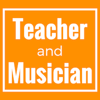I’m taking the time to have a look at each of the draft specifications that were published last week and write a few observations. This isn’t a comprehensive compare/contrast exercise so, if that’s what you’re looking for, then you’d be well advised to have a look at this document written by Alison Daubney for the ISM. These posts are intended to be entirely subjective and may well create more questions than answers! So, with your expectations well and truly managed, let’s start with AQA’s specification for GCSE Music.
A move to set works
A few years ago, I hated the idea of a set work. I take issue with the idea that there’s a canon of music that should be studied by all pupils and I’m uneasy with pointing to certain pieces of music as being ‘the best’ or even just ‘the best examples of something’. I still hold this aversion to canons but, almost paradoxically, I quite like the idea of set works. There’s one simple reason for this – set works are great for workshopping.
Workshopping a piece of music with a class is a great way to:
- explore what makes that piece of music ‘tick’
- improve the performing skills of your pupils
- give pupils a ‘personal’ experience of the music
- model the process of composing a piece that’s inspired by another
With set works, workshopping can be very easily targeted at the needs of both the pupils as musicians and the requirements of the course. I was particularly pleased to notice in
this document, that AQA intends to create ‘classroom performance editions’ of each piece (presumably a bit like a Kaleidoscope arrangement), which should be a great resource for teachers when planning how to workshop each piece.
As pleased as I am that the Beatles were included in the set works, I’m surprised that they’re the only artist recognised in this area of study. I do feel that it may have been wiser to choose three songs by three different artists than three songs from the same album.
Turntablism
Is it just me or has the press release mentioning turntablism been a bit overplayed? I’m struggling to see how this is noticeably different from the current range of GCSEs. If I’ve missed something, please do point it out to me.
The layout of the specification
I must admit that I thought the specification was very clearly laid out. I do like that each area of study had it’s own list of vocabulary mapped against the elements of music and that the presentation of the mark schemes is a noticeable improvement on previous AQA specifications. Similarly, definitions of each type of performance are much clearer than in previous years – this should be helpful for teachers.
Annotation or Written Account?
In the guidance for what to include when submitting a composition, I did notice that ‘annotation’ and ‘written account’ are seen as two separate things and the latter is only acceptable for ‘music production’.
- Written account – “Providing a detailed guide through the aural experience of the piece that will highlight structure and musical ideas, including the ways in which they have been explored.”
- Annotation – “Including details of the processes, devices and
techniques used, showing how the areas
detailed in the criteria contributed to the final
composition.”
These new definitions will need to be considered carefully by teachers and AQA should be sure to provide plenty of examples of each.
More reactions
I’m looking forward to hearing how other people have reacted to this. Tomorrow’s
MufuChat should be a great opportunity to discuss this and the post-chat is already
live on Peer to Peer.

